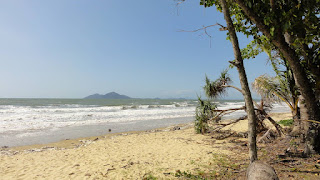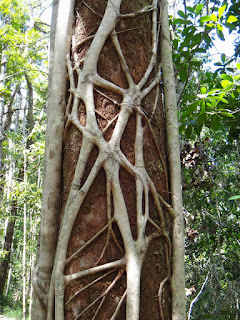Note that QLD National Parks has just changed all its park names to aboriginal names (which seem too hard to pronounce or remember).
Rainforest and...
...creeks everywhere!
The Gympie stinging tree (Dendrocnide moroides) loves to grow in disturbed areas and along walking tracks! It is amazing that people don't get stung more often.
The Boulders Scenic Reserve, Wooroonooran National Park.
Eubenangee Swamp National Park.
Nandroya Falls, Wooroonooran National Park
View from Mamu Rainforest Canopy Walkway.
Mission Beach - the camping area is right on the beach!
View from Bicton Hill, Djiru National Park: looking south with Mission Beach and Dunk Island in the back-ground.
Fan Palm Forest, Djiru National Park. All other tree species fell during Cyclone Yasi, but somehow the palms survived.
The town of Tully is apparently the wettest place in Australia. This gumboot is 7.9m high, which is the highest recorded annual rainfall for Tully, average is around 4m/year!!
Sugar cane harvesting and ..
.. the (Chinese owned) mill in Tully.
Kirsten during the sugar mill tour. There was steam, dripping hot water, sticky floors and dust everywhere. Maybe the Chinese don't have to follow Australian work-safety rules?
Murray Falls in Girramay National Park.
Broadwater camp ground in Abergowrie State Forest.
Wallaman Falls in Girringun National Park - the largest, permanent, single-drop waterfall in Australia (268m drop).
The walk to the bottom was very hot and steamy - and then the track stops about 100m before reaching the swimming hole!
The port of Lucinda has the longest jetty in the world, extending for 5.6 km and dipping 1.2 m over its length as it follows the curvature of the earth!! It contains a conveyor belt to load raw sugar onto ships.
Here, some more impressions from the wet tropics:
Strangler .....
... and Buttress Fig.
Green tree ants (Oecophylla smaragdina) have been our companions since Cape York. Every morning our tent was included in their "foraging highway" and every time you brush against a plant you end up wearing a few of them. Cute aren't they?
And what's this?? Yes! It's poo. From a Cassowary. It's a great way to show how important these rare giants are for the survival of the rainforest. Some of these seeds are the size of golf balls and depend on Cassowaries for their dispersal and fertilisation. So don't speed in the rainforest!
Somebody with a sense of humour changed a "bump" sign into a dead Cassowary.
These gorgeous creatures were hanging out in the toilet on a camp ground. They are probably just too hard to spot in the wild!

































No comments:
Post a Comment